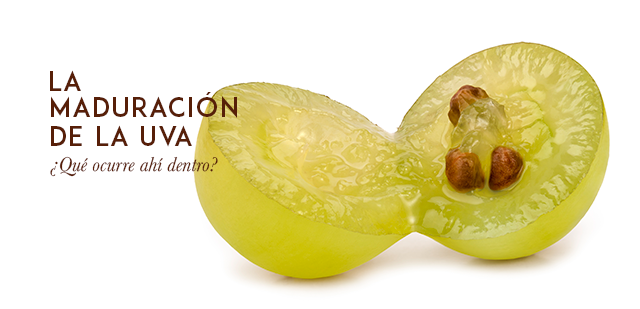GRAPE RIPENING

It is almost harvest time. The moment to reap the rewards of all the effort put into the vineyard throughout the year. The berries have grown into beautiful grapes and are now at the peak of maturity, but… what exactly do we mean by fruit “maturity”? What happens in there? What should we be paying attention to?
Before getting into the details, it’s worth taking a look at the differences between the physiological maturation of the plant and that of the phenolic compounds: in other words, the development of the compounds that give wine its color, texture and flavor. This is the maturation we’re interested in.
Simply put, we can classify the decisive factors involved in grape ripening according to the accumulation of sugars, the decrease in acid levels, and the development of the aforementioned phenolic and aromatic varietal compounds.
[[{"fid":"8589","view_mode":"default","fields":{"format":"default","field_file_image_alt_text[und][0][value]":false,"field_file_image_title_text[und][0][value]":false},"type":"media","link_text":null,"attributes":{"height":448,"width":671,"class":"media-element file-default"}}]]
A flowering Cabernet Sauvignon cluster at the Mas La Plana vineyard, El Penedès
ACCUMULATION OF SUGARS
- The ripening process begins once the vine shoots are fully grown. This is when the plant’s metabolism starts to translocate or move sugars towards the organs that also store the vine’s reserves: the clusters and shoots.
- At the same time, malic acid is turned into sugar, but these quantities are insignificant.
- Glucose and fructose accumulate in the berries. Whereas young grapes, which are still green, mainly contain glucose, towards the end of veraison, fructose levels increase and, in some varieties, eventually even exceed those of glucose.
Sugar levels depend on the variety, the climate of a given year, the geological characteristics of the soil, the amount of water stored, and all of the winegrowing techniques that are used, such as the choice of rootstock, which influences plant vigor; yields; the length of the vegetative cycle and the amount of sugar in the berries.
[[{"fid":"8590","view_mode":"default","fields":{"format":"default","field_file_image_alt_text[und][0][value]":false,"field_file_image_title_text[und][0][value]":false},"type":"media","link_text":null,"attributes":{"height":422,"width":633,"class":"media-element file-default"}}]]
Ripe Cariñena grapes moments before the harvest, Grans Muralles vineyard, Conca de Barberà
DECREASE IN ACID LEVELS
During vegetative growth, the leaves and green berries contain organic acids that break down during maturation. The main reasons for this are as follows:
- As the summer months wear on, the heat decreases the rate of respiration that nourishes the various acids present in the plant. The higher the heat, the greater the breakdown and resulting loss of malic and tartaric acid.
Similar to sugar, the final acid levels in a cluster vary according to the interaction between the variety and its rootstock, as well as the characteristics of the environment.
- Malic acid, meanwhile, is transformed into sugar. Tartaric acid levels, however, stay more or less the same, because the plant transfers very little acid to the fruit.
- The amount of water the berry retains is also crucial, because it helps dilute the acids inside the grape.
THE DEVELOPMENT OF PHENOLIC COMPOUNDS
Here we’re talking about organic substances whose chemical structure involves one or more compounds known as “phenols.” These compounds play an important role in the pigment, texture and flavors of a wine.
Among the phenolic compounds, we find phenolic acids, anthocyanins (pigments), flavonoids (yellow pigments), and tannins, which add color, texture and astringency.
The development of tannins and anthocyanins is a determining factor in grape quality, but where exactly do we find them?
- In the skins: Anthocyanins develop during veraison. The grape skins also contain phenolic acids, tannins and some flavonols. An increase in tannin content is normally associated with varieties rich in sugar.
- In the pulp or flesh: Here we mostly find phenolic acids, some tannins and, on rare occasions, anthocyanins.
- In the seeds and stems: Rich in tannins that are bitterer than those found in the flesh. They also contain phenolic acids.
[[{"fid":"8618","view_mode":"default","fields":{"format":"default","field_file_image_alt_text[und][0][value]":false,"field_file_image_title_text[und][0][value]":false},"type":"media","link_text":null,"attributes":{"height":527,"width":693,"class":"media-element file-default"}}]]
THE AROMATIC COMPOUNDS
A wine’s aromatic compounds develop in the vine, as determined by the variety, and during the vinification process.
This means the aromatic potential of a wine depends on the presence of different substances:
- As free-form molecules, substances like terpenes and terpenic alcohols are perceptible on the vine. Although terrible sounding, these compounds are essential to creating varietal typicity, for example in a variety like Muscat.
- When combined, these same molecules constitute aromatic precursors in the grape, made up of polyterpenes, monoterpenes, phenolic acids and other compounds. Their aromatic potential, however, will not be expressed until the wine is vinified and aged.
As you can see, grape maturation is a process that involves the magic of nature, the hand of experience and the cultural practices of humankind. An example of organic symbiosis that finds its finest form and expression in wine.
